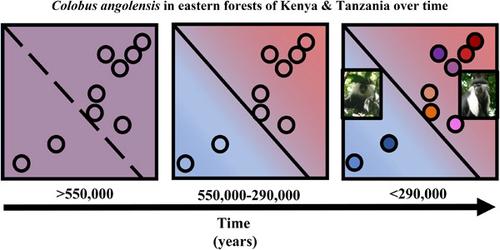当前位置:
X-MOL 学术
›
Am. J. Primatol.
›
论文详情
Our official English website, www.x-mol.net, welcomes your
feedback! (Note: you will need to create a separate account there.)
Mitochondrial genetic diversity and divergence dating of Angolan colobus monkeys (Colobus angolensis) in the eastern forests of Kenya and Tanzania: Implications for subspeciation and reconstructing historical biogeography
American Journal of Primatology ( IF 2.0 ) Pub Date : 2022-04-07 , DOI: 10.1002/ajp.23384 Monica M McDonald 1, 2 , Pamela M K Cunneyworth 3 , Aaron G Anderson 2 , Emily Wroblewski 2
American Journal of Primatology ( IF 2.0 ) Pub Date : 2022-04-07 , DOI: 10.1002/ajp.23384 Monica M McDonald 1, 2 , Pamela M K Cunneyworth 3 , Aaron G Anderson 2 , Emily Wroblewski 2
Affiliation

|
Whether the Colobus angolensis that reside in the fragmented forests in eastern Kenya and Tanzania represent one subspecies or two has been debated for 50 years. Morphological and more recent genetic and ecological studies suggest that these populations represent two subspecies, C. a. palliatus and C. a. sharpei. However, their distribution of mitochondrial variation remains unresolved since the genetic study only characterized four populations at the range ends. Therefore, we characterized five populations in the area of the hypothesized subspecies divide. We identified eight new haplotypes which, combined with those previously identified, provided 26 haplotypes from nine populations for analysis. Haplotypes found south of the Rufiji River cluster together but separately from northern haplotypes. The largest sequence differences within cytochrome b occur between population pairs representing opposite sides of the river; their mean difference (1.5%) is more than that of other primate subspecies. Analysis of molecular variance attributes most of the variation to that north versus south of the river. These results support the previous subspecies distinction between C. a. palliatus (northern) and C. a. sharpei (southern), divided by the Rufiji River. The estimated time of the most recent common ancestor of all haplotypes indicates that the subspecies have been isolated from each other for approximately 550,000 years. The common ancestor of northern and southern haplogroups was 370,000 and 290,000 years ago, respectively. Nevertheless, the correlation between genetic and geographic distances suggests that isolation-by-distance contributed to population structuring. Significant variation among populations, with only three haplotypes shared between populations, also indicates that an extended period of isolation drove population distinctiveness. Considering these results, we evaluate hypotheses about the founding and differentiation of these subspecies during Pleistocene climatic fluctuations and propose a novel, more direct migration route from Central Africa to their current range navigating Lake Tanganyika, the central Tanzanian corridor, and the Rufiji River.
中文翻译:

肯尼亚和坦桑尼亚东部森林中安哥拉疣猴 (Colobus angolensis) 的线粒体遗传多样性和分歧年代测定:对亚种形成和重建历史生物地理学的启示
居住在肯尼亚东部和坦桑尼亚破碎森林中的安哥拉疣猴是否代表一个或两个亚种已经争论了 50 年。形态学和最近的遗传和生态学研究表明,这些种群代表两个亚种,C. a. palliatus和C. a. 沙皮犬. 然而,它们的线粒体变异分布仍未解决,因为遗传研究仅对范围末端的四个种群进行了表征。因此,我们对假设的亚种划分区域的五个种群进行了表征。我们确定了八种新的单倍型,与之前确定的单倍型相结合,提供了来自九个群体的 26 种单倍型进行分析。在鲁菲吉河以南发现的单倍型聚集在一起,但与北部的单倍型分开。细胞色素b内最大的序列差异发生在代表河流两岸的人口对之间;它们的平均差异(1.5%)大于其他灵长类亚种。分子方差分析将大部分变异归因于河流的北部和南部。这些结果支持C. a.之前的亚种区分。palliatus(北部)和C. a. 沙皮犬(南部),被鲁菲吉河隔开。所有单倍型的最近共同祖先的估计时间表明,这些亚种已经相互分离了大约 550,000 年。北方和南方单倍群的共同祖先分别是 37 万年前和 29 万年前。然而,遗传距离和地理距离之间的相关性表明,距离隔离有助于种群结构。种群之间的显着差异,种群之间仅共享三种单倍型,也表明长时间的隔离推动了种群的独特性。考虑到这些结果,我们评估了关于更新世气候波动期间这些亚种的建立和分化的假设,并提出了一个新的,
更新日期:2022-04-07
中文翻译:

肯尼亚和坦桑尼亚东部森林中安哥拉疣猴 (Colobus angolensis) 的线粒体遗传多样性和分歧年代测定:对亚种形成和重建历史生物地理学的启示
居住在肯尼亚东部和坦桑尼亚破碎森林中的安哥拉疣猴是否代表一个或两个亚种已经争论了 50 年。形态学和最近的遗传和生态学研究表明,这些种群代表两个亚种,C. a. palliatus和C. a. 沙皮犬. 然而,它们的线粒体变异分布仍未解决,因为遗传研究仅对范围末端的四个种群进行了表征。因此,我们对假设的亚种划分区域的五个种群进行了表征。我们确定了八种新的单倍型,与之前确定的单倍型相结合,提供了来自九个群体的 26 种单倍型进行分析。在鲁菲吉河以南发现的单倍型聚集在一起,但与北部的单倍型分开。细胞色素b内最大的序列差异发生在代表河流两岸的人口对之间;它们的平均差异(1.5%)大于其他灵长类亚种。分子方差分析将大部分变异归因于河流的北部和南部。这些结果支持C. a.之前的亚种区分。palliatus(北部)和C. a. 沙皮犬(南部),被鲁菲吉河隔开。所有单倍型的最近共同祖先的估计时间表明,这些亚种已经相互分离了大约 550,000 年。北方和南方单倍群的共同祖先分别是 37 万年前和 29 万年前。然而,遗传距离和地理距离之间的相关性表明,距离隔离有助于种群结构。种群之间的显着差异,种群之间仅共享三种单倍型,也表明长时间的隔离推动了种群的独特性。考虑到这些结果,我们评估了关于更新世气候波动期间这些亚种的建立和分化的假设,并提出了一个新的,











































 京公网安备 11010802027423号
京公网安备 11010802027423号